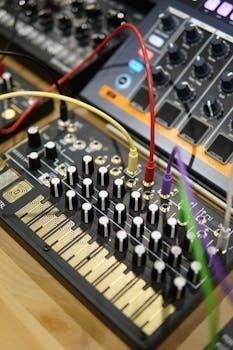Hayman Reese electric brake controllers are essential for safe towing, regulating trailer braking force to prevent skidding, swaying, and jack-knifing․ These controllers also reduce wear on vehicle brakes and tires while improving fuel efficiency, offering advanced control and safety features․
Understanding the Importance of Brake Controllers
Brake controllers are pivotal for safe and smooth towing, regulating the braking force applied to a trailer or caravan when it’s being towed by a vehicle․ This regulation is crucial for preventing dangerous situations such as trailer skidding, swaying, or jack-knifing․ The use of a brake controller enhances the stability of the towing setup and ensures that the trailer brakes engage in sync with the tow vehicle’s brakes, providing a more controlled stopping process․ Furthermore, by effectively distributing the braking load, brake controllers help reduce the strain and wear on the tow vehicle’s brakes and tires․ This not only extends the lifespan of these components but also contributes to better fuel efficiency during towing․ Ultimately, a properly functioning brake controller is a fundamental component for anyone involved in towing, providing safety and peace of mind on the road by assisting in a balanced and responsive braking operation․

Hayman Reese Guardian IQ Model 5900
The Hayman Reese Guardian IQ Model 5900 is a compact electric brake controller designed for easy dash mounting․ It features push-button controls, a digital display, and a manual override for enhanced control․
Key Features of the Guardian IQ Controller
The Guardian IQ Model 5900 boasts several key features, including its compact design, making it easy to mount on the dashboard of various vehicles, such as 4WDs, light caravans, and campers․ The controller provides easily accessible push buttons for controlling output and sync settings, enabling precise adjustments to braking power․ Its user-friendly digital display clearly communicates brake power output, sync settings, and any error codes that may arise during operation․ Additionally, the Guardian IQ includes a thumb control manual override feature, allowing for immediate brake activation when needed․ The controller’s plug-and-play feature facilitates quick and easy connections with compatible Hayman Reese wiring harnesses, simplifying installation․ This controller’s design ensures adaptability to different trailers, making it a versatile choice for various towing needs․ The intuitive interface and robust construction make it a reliable tool for safe and controlled towing experiences, offering peace of mind on the road․
Installation Overview of the Guardian IQ
Installing the Hayman Reese Guardian IQ brake controller involves several key steps․ First, route the brake controller power harness towards the designated mounting location, typically on the dashboard, using cable ties to secure the harness; Ensure all connections are made to a 12-volt negative ground system, taking care to avoid reversing the black and white wires to prevent damage to the controller․ The Guardian IQ comes with a mounting bracket and hardware for easy installation․ This controller also features a plug-and-play design for quick connection with the Hayman Reese SmartClick brake control harness․ The wiring harness should be connected to the vehicle’s brake light circuit and battery power source․ Thoroughly check all wire connections to ensure proper functionality․ Following the included instructions carefully is crucial for successful installation and operation․ Remember, the controller should be mounted in a location that allows easy access to the manual control and visibility of the display, ensuring safe and reliable performance․
Essential Components of a Brake Controller System
A brake controller system includes control elements like output, sync, and manual controls, a wiring harness for vehicle connections, and the controller unit itself․ Understanding each component is crucial for proper operation and safety․
Control Elements⁚ Output, Sync, and Manual
The Hayman Reese brake controller features distinct control elements⁚ output, sync, and manual․ The output control, often a gain adjustment, regulates the overall braking power delivered to the trailer․ The sync control coordinates the trailer brakes with the tow vehicle’s brakes, preventing jerky stops․ This setting is adjusted for driver preference or changing road conditions․ A manual override provides immediate trailer braking when needed, regardless of the tow vehicle’s braking․ The manual control is typically located on the front of the brake controller unit, allowing the driver easy access for instant activation․ These controls work together to ensure a safe and smooth towing experience․ Properly adjusting these elements is crucial for optimal braking performance, and the manual control may not disengage cruise control on some vehicles․ The output is often a rotary knob or buttons for increasing or decreasing brake power․
Wiring Harness and Connections
A proper wiring harness and secure connections are critical for the effective operation of a Hayman Reese electric brake controller․ The wiring harness facilitates the electrical link between the tow vehicle and the trailer brakes․ Typically, a separate wiring harness needs to be purchased if one is not already present in the vehicle․ The Hayman Reese SmartClick brake control harness offers a plug-and-play feature for easy installation․ It is essential to properly route the brake controller power harness towards its mounting location․ Secure the harness using cable ties to avoid any loose connections․ Always be sure to avoid any reversing the black and white wires, as improper wiring can damage or destroy the brake controller․ Pay careful attention to the instructions and ensure all connections are clean and free of corrosion before connecting the system․ A bad ground or a short to the blue brake output wire can cause issues․

Troubleshooting Common Issues
Common issues with Hayman Reese brake controllers often involve error codes like “OL” or “ER,” indicating overload or internal problems․ These require careful diagnosis of wiring, connections, and brake magnets to resolve․
Decoding the “OL” Error Code
The “OL” error code on a Hayman Reese electric brake controller signifies an overload condition, typically stemming from an issue within the trailer’s braking circuit․ This often points to an excessive current draw, which can be caused by several factors․ A common culprit is a short circuit in the blue brake output wire, which carries power to the trailer brakes․ Alternatively, a poor ground connection can also trigger this error, disrupting the proper flow of electricity․ Another potential cause could be damaged or worn brake magnets within the trailer’s brake assembly, leading to increased resistance and current draw․ Furthermore, corrosion or dirt in the vehicle’s or trailer’s electrical connectors can also result in a faulty circuit, prompting the controller to display the “OL” code․ To diagnose the exact cause, a systematic inspection of wiring, connections, and magnets is necessary, along with cleaning and testing these components for faults․
Understanding the “ER” Error Code
The “ER” error code displayed on a Hayman Reese electric brake controller typically indicates an internal fault within the controller itself, suggesting a problem that cannot be resolved through external adjustments or repairs․ This code signals that the controller’s internal electronics are malfunctioning, often requiring a complete replacement of the unit․ Unlike the “OL” code, which points to external wiring or brake system issues, the “ER” code is specific to the controller’s internal circuitry․ While the controller may temporarily appear to function normally, the “ER” code indicates an impending failure or an unreliable output․ It’s a signal that the controller is no longer operating within its specified parameters and cannot be trusted for consistent braking performance․ Therefore, when this error code appears, it’s recommended to replace the brake controller as soon as possible to ensure safe towing․

Advanced Diagnostics
Advanced diagnostics involve testing brake magnets with an ammeter to check amperage and an ohmmeter to check resistance․ Checking for shorts and grounds ensures the wiring is secure and functioning correctly within the system․
Testing Brake Magnets
To effectively test brake magnets, ensure the trailer is disconnected to prevent damage to the controller or other electrical components․ Use an ammeter connected between a separate battery’s positive terminal and one magnet wire, with the other magnet wire connected to the negative terminal․ Check the amperage; if it exceeds the specified range, replace the magnet․ If the reading is low, the leads are bad․ Next, connect the negative wire to the magnet’s base; any amperage indicates a short, requiring replacement․ Finally, use an ohmmeter to check resistance between magnet wires․ Replace the magnet if the resistance is outside the specified range, typically 3․8-4․0 Ohms for 7-inch magnets and 3․2-3․5 Ohms for 10-12 inch magnets․ These tests ensure the magnets are functioning correctly for safe braking․
Checking for Shorts and Grounds
When diagnosing issues with your Hayman Reese brake controller, thoroughly checking for shorts and grounds is crucial․ Start by inspecting the vehicle’s connector and the trailer’s connector for dirt or corrosion, as these can cause poor connections․ Clean them meticulously to ensure a reliable ground․ Next, examine the brake controller’s white wire connection to the ground point, along with the 7-way ground and the trailer ground for any signs of corrosion or looseness․ A loose or broken wire can also cause problems, so carefully trace all wiring to identify any damaged sections․ Also, ensure to check the trailer grounds for similar issues․ These steps will help isolate any short circuits or bad ground connections that may be causing controller malfunctions․

Additional Considerations
When using Hayman Reese brake controllers, ensure compatibility with your trailer’s brake type․ Always follow installation instructions carefully for optimal performance and safety, as correct wiring is paramount to avoid system damage․
Compatibility with Different Trailer Brakes
Hayman Reese electric brake controllers are designed primarily for use with electric trailer brakes, which are commonly found on caravans and larger trailers․ It’s crucial to verify the compatibility of your specific brake controller model with the type of brakes installed on your trailer․ Electric brakes function by using electromagnets to activate the braking mechanism, requiring a controller that can accurately manage this electrical current․ While these controllers are generally suitable for most electric brake setups, some may not be compatible with electric-over-hydraulic systems․ It is essential to consult the product manual and specifications to ensure that the selected Hayman Reese controller is appropriate for your trailer’s braking system to maintain safety and optimal performance․ Using a mismatched controller can lead to ineffective braking or even damage the system, so double-checking compatibility is a crucial step in the installation process․
Importance of Following Installation Instructions
Adhering strictly to the Hayman Reese installation instructions is paramount to ensure the proper and safe operation of your electric brake controller․ These instructions provide specific guidance on wiring connections, mounting locations, and system configurations․ Incorrect wiring can lead to malfunctions, including the display of error codes like “OL” or “ER,” which indicate overloads or internal faults․ Furthermore, improper mounting can affect the controller’s performance and longevity․ Detailed instructions often include important safety warnings, ensuring that the system is installed correctly to avoid potential hazards․ Following the manual guarantees that the controller will function as intended, providing reliable and consistent braking for your trailer․ It also helps in preserving the controller’s warranty and prevents costly repairs․ Therefore, taking the time to thoroughly understand and follow the installation instructions will contribute to a safe and effective towing experience․
